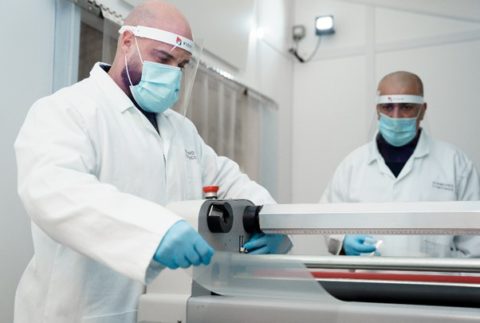
The Leading AR Optical Coatings Supplier
After decades in the industry, Diamond Coatings has established itself as the leading supplier of AR optical coatings globally.

ITO (Indium Tin Oxide) has become one of the most commonly used transparent conducting oxides with applications in a range of areas and industries, the predominant use of ITO coatings being touchscreen technology for smartphones, tablets and other electrical appliances.
The optical transparency and electrical conductivity that using ITO provides has led to its extensive use, as well as the relative ease by which it is deposited onto substrates such as glass, plastic and thin film.
Indium Tin Oxide coatings for touchscreens are used to produce both capacitive and resistive touchscreens. These two types of touchscreen technology have different mechanics and both offer advantages that make each more suited to certain applications and products.
Diamond Coatings have positioned themselves as the leading Touch Screen Manufacturers within the UK and provide both capacitive and resistive touch screens, from development to production volumes, and in a range of sizes. The screens can be provided with anti-glare and other finishes as required, and can be applied to plastic or glass.
Indium Tin Oxide Capacitive Touchscreens
Capacitive touch screens require a conductive and transparent surface which is why ITO has become such a key feature in these products. ITO films or coatings are applied to relevant parts of the capacitive touch screen.
Capacitive touch screens and displays are used across many industries and are often used in consumer electronics such as laptops, phones and tablets, due to their ability to register multiple touches at once and the high visible transmission they offer.
Capacitive touchscreens utilise the fact that the human body is conductive to detect touch. There are two types of capacitive screens, the surface and projected capacitive.
While the surface capacitive screens use an electrode in each corner to detect touch, the projected capacitive screens use a matrix of capacitors to project an electrostatic field which allows the screens to detect touch.
Capacitive screens are most used in consumer electronics such as laptops, phones and tablets due to their ability to register multiple touches simultaneously and longer life, they also have a higher visible transmission of around 90 percent.
The downsides of capacitive screens are the increased cost, the decreased flexibility of use and they are more susceptible to water and dust damage.
The range of applications is diverse, from use in ATMs to musical instruments. There are further applications in processing and manufacturing, military and education and much more.
Indium tin oxide can be used to coat parts of capacitive touch screens and can be applied in the form of an ITO film or can be a directly deposited ITO coating.
ITO films are only suitable for use on flat surfaces, whereas when ITO is directly deposited onto a part it can be applied to smooth, curved, 3D, grained and textured surfaces. Opting for ITO film can unfortunately have some drawbacks, as it can be prone to problems like delamination, bubbling and subsequent functional issues.
Directly coated ITO parts are optically superior in comparison to ITO films. Every interface causes reflection, and ITO films have twice the number of interfaces ITO coated parts have. Touch screen that use ITO films reflect considerably more light and subsequently offer substantially lower rates of transmission.
It can also be difficult to achieve the conductivity required by capacitive touch solutions with ITO films.
Directly coated ITO parts can be offered at far more competitive prices than ITO film-based solutions, the production of which requires significantly more processing stages and labour costs.
Indium Tin Oxide Resistive Touchscreens
Resistive touchscreens, which rely on the mechanical pressure exerted by the finger or stylus to detect movement, is the most common type of touchscreen in use, due to its lower price and ease of use.
These screens usually use two layers with a small gap between them, the outer layer is usually a clear polycarbonate layer while the inside layer is rigid and often made of glass or PET film.
Resistive screens are most commonly used in manufacturing, ATMs and medical technology. Due to the way they are designed, the screens are typically single touch devices, only capable of reading a single touch at a time but are capable of being used while wearing gloves unlike most capacitive screens.
The downside of resistive touch screens is increased glare due to the extra reflective surfaces and less accurate input.
Diamond Coatings are experienced and able to provide ITO coated touchscreens, to meet your specific requirements. If you would like to speak to an expert, do not hesitate to contact the team today for more information.

After decades in the industry, Diamond Coatings has established itself as the leading supplier of AR optical coatings globally.

What Is An Electrically Conductive Coating Used For? Electrically conductive coatings possess a unique capability—they conduct electric current along their surfaces. These coatings serve diverse

Diamond Coatings offer a range of premium quality Aluminium Tapes that stand as a testament to their commitment to excellence.

Whether it’s display screens, architectural windows, or precision optics, anti-reflection coated screens reduce reflections and improve visual comfort
If you are interested in any of our products or services, please use the contact form or give us a call, we will be happy to discuss how we may be able to help you.